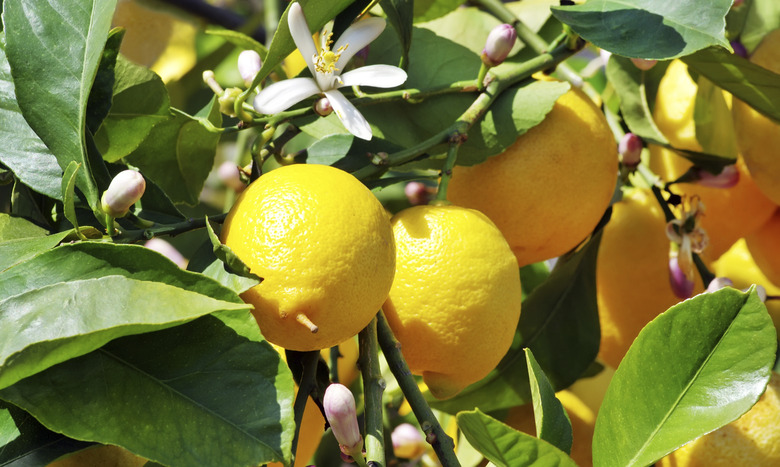Why Are My Lemon Tree's Leaves Sticky?
We may receive a commission on purchases made from links.
Why are your lemon tree's leaves sticky? When sticky goo gives the glossy green leaves of your lemon tree (Citrus x limon) an extra shine, don't despair. The additional polish is honeydew, the waste of sap-draining insects. The messy bugs attack lemon trees throughout their growing range in U.S. Department of Agriculture plant hardiness zones 9 through 11. Honeydew is a sticky problem, but it's not difficult to cure.
Tip
Lemon tree leaves often become sticky when sap-draining insects attack the tree and cause honeydew to develop on the leaves.
Lemon Tree Sticky Leaves Causes
Lemon Tree Sticky Leaves Causes
If you're new to gardening, the word "honeydew" may conjure pictures of fairies gathering to sip magical elixir from buttercups at dawn. A more realistic image is that of hoardes of scale insects, aphids, whiteflies or mealybugs robbing tender leaves and stems of nutrient-rich sap.
The pests look different, but their method of operation is the same. Each attaches to the tree with needlelike, fluid-draining mouth parts. After metabolizing its nitrogen, they all excrete the leftover sap as honeydew.
Basics of Honeydew
Basics of Honeydew
Honeydew clings to leaves, branches and nearby objects, attracting sooty mold spores that germinate into greasy black fungus. Heavy sooty mold layers may block sunlight and interfere with the lemon tree's photosynthesis process.
Microbes feeding within the honeydew produce compounds are called semiochemicals. Ironically, the scent of semiochemicals lures beneficial insects, such as green lacewings and hoverflies, to prey on the honeydew producers.
Attraction of Ants
Attraction of Ants
Where honeydew appears, sugar-craving ants almost certainly follow. They safeguard the goo by killing the beneficial bugs, and increase their supply by herding the sap thieves to unpopulated leaves.
Limit the ants' access to your tree by pruning the branches back to 2 feet from nearby structures, plants and the ground using a sharp pruning saw. Trap the ants on the trunk by wrapping it with a 6-inch band of heavy, petroleum jelly-coated paper. Check the paper regularly and replace it when it's full of ants.
Destroy ants at their source by placing slow-acting, ready-to-use enclosed ant baits along their trails. Sugar-based boric-acid baits are effective. Foraging ants carry it back to the nests, where it kills the underground colonies in a few weeks.
How to Correct the Issue
How to Correct the Issue
Once the ants are controlled, manage minor honeydew by pruning the affected twigs and leaves. To avoid spreading disease, disinfect your pruning tools by dipping them in rubbing alcohol before making each cut.
Hosing the tree off with a strong spray of water dislodges aphids, mealybugs and adult whiteflies. Use this method early in the day so the leaves dry quickly.
Treat large insect infestations with organic, ready-to-use insecticidal soap. It smothers all four pests on contact, without harming the bees arriving after it dries. Avoid spraying soap on lemon trees when they're flowering. When no direct sun is on the tree, spray until it drips from the entire plant, making sure to hit the backs of the leaves.
Repeat the application every two to three days, or at the label's recommended frequency, until the number of pests is small enough for their predators to manage. Always heed the label's precautions and dress in protective clothing, including safety goggles, when using the soap.
